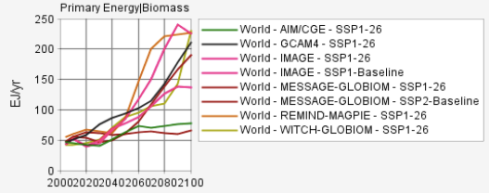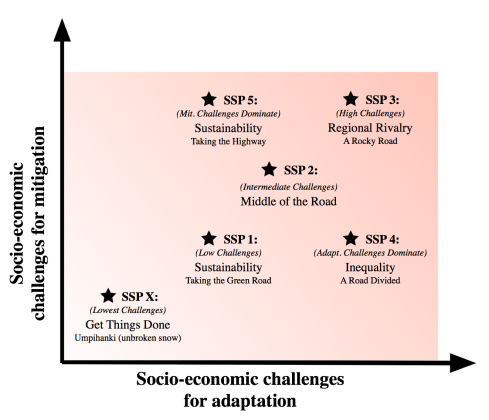You are currently browsing the monthly archive for March 2018.
People building integrated assessment models (IAMs) for IPCC (among others) nowadays use set of narratives called “Shared socioeconomic pathways” (SSPs). These narratives are used to justify inputs, assumptions, and constraints of the models. There appears to be 5 set of narratives with a goal of “covering the uncertainty space of challenges to adaptation and mitigation.” or “spanning a relevant range of uncertainty in societal futures”. I do not think they succeed at this sufficiently well. These narratives influence the outcomes of the models, but are naturally mainly windows into modellers minds and I am at difficulty in seeing what their point even is. They do encourage pigeonholing discussions around the narratives, but why would that be a good thing? Well, be that as it may, a brief summary of the narratives the way I see them:

Shared socioeconomic pathways according to O’Neill et al.
- SSP 1: This is clearly where good moral people are supposed to migrate. Word salad of lovely buzzwords. Assumes efficiency and carbon intensities far outside historical norms and seems to have inexplicably internalized anti-nuclear bias as if this would have something to do with the stated goals of sustainability and inclusive development. Interestingly it is also a narrative of fairly high economic growth. Certainly not dramatically different from SSP 2.
- SSP 2: “Middle of the road”…well that is not inspiring, but at least there is some attempt to stick to historical norms on issues like carbon intensity and efficiency improvements. Narrative for middle aged men in gray suits.
- SSP 3: This is the dystopia. Only bad person would like this to happen. I will mostly skip this.
- SSP 4: Here you have some pro-nuclear assumptions, but strangely it is coupled to a scenario with increasing inequalities. How this happened is unclear.
- SSP 5: “Fossil-fueled development—Taking the highway”. This one in fact has plenty of socially progressive elements (just like SSP 1), but as a poison pill it is attached to fossil fuels by assumption. This has more globalization than SSP 1 and has an emphasis on competition. High economic growth so that GDP at 2100 can be substantially higher than in SPP 1.

How the carbon intensity and energy intensities develop in different narratives? SSP 2 and SSP 4 baselines seem to start from historical norms. SSP 1 way off.
SSP 1 seems to have many nice things I endorse, but sadly I am afraid it is riddled in internal conflicts. The stated aims are not clearly consistent with what is actually fed into the computers. Case in point – bioenergy. Relating to SSP 1 modellers state: “The choice to interpret the SSP1 storyline consistent with the “global sustainability” scenario family is consistent with the storyline described in O’Neill et al. (2017). For instance, the important role for bio-energy, renewables and CCS (in the climate policy case) perfectly fit in this interpretation of the SSP1 storyline…” What? Some of the modelling results can be explored in this database. So lets have a look.

The 2.6 scenarios of the SSP 1 narrative typically see huge increases in biomass burning over the baseline. Very large fraction of this is supposed to happen with carbon capture which starts within next decade.
So SPP 1 narratives (and most others) typically end up with colossal role for bioenergy and so that very large fraction of that is equipped with carbon capture. Words: “sustainable path”, “respects environmental boundaries”, “lower resource intensity”. Actions: increase human appropriation of primary productivity massively without any serious consideration of social or ecological impacts. I spot a fairly serious problem here and this is a problem that has been around for a while (read my earlier observations on this here). Incentives for huge increases in bioenergy are created, but miraculously this would not affect food production or its yield development in any negative way and nor would it cause ecological damage worth mentioning. Gratefully criticism of this recklessness has been mounting and for a fresh summary I encourage you to read the column by Chelsey Harvey in the Scientific American.

Some typical bioenergy projections. Insanity across the narratives. All within planetary boundaries of course. #sarcasm

Implications of bioenergy expansion. Less natural habitats and more bioenergy plantations than farms for crops. Bioenergy volumes around 4x the crop volumes.
As I explored the narratives I noticed that I have been written out of existence. There is no narrative that represents me! An omission of this magnitude is clearly intolerable and I will try to start fixing it here. Below I provide a draft of my favoured narrative, but in case someone wishes to draft a better one, here is a link to a document and you are free to suggest improvements. Since SSP 1 assumes unjustified limitations on the acceptable toolboxes both technologically as well as socially, my narrative implies lower challenges to both mitigation and adaptation.

Fixed it! Umpihanki refers to a famous poem by Aaro Hellaakoski “Tietä käyden tien on vanki, vapaa on vain umpihanki.” Poor translation could be “Going by the road is to be imprisoned by the road, only free is the unbroken snow.”
SSP X – The missing pathway :
After a period of confusion world shifts towards prioritizing inclusive development and minimization of ecological damage. This transition is driven by increasing awareness of the endemic failure of climate policies as well as dissatisfaction in economic arrangements broadly considered as unfair and counter-productive. Educational and health investments accelerate the demographic transition, leading to a relatively low population. Driven by an increasing commitment to achieving development goals, inequality is reduced both across and within countries. At the same time, the improvements in human well-being, along with strong and flexible global, regional, and national institutions imply low challenges to adaptation. World places increasing faith in innovation and participatory societies to produce rapid technological progress and development of human capital as the path to sustainable development. There are also strong investments in health, education, and institutions to enhance human and social capital. International mobility is increased by gradually opening up labor markets as income disparities decrease.
Focus on results drives people towards pragmatic solutions and away from predetermined acceptable toolboxes and pathways. Grand narratives are seen as a sources of amusement and aids for imagination, but humanity is not constraint by them. All ecologically low impact tools for mitigation and adaptation are accepted, including non-biomass renewable energy, nuclear power, CCS, GMOs, and geoengineering as well as social changes influencing, for example, diets, car ownership, and urban planning. People realize the fundamental value of the broad set of options for themselves as well as for future generations.
How much is invested in which tool is a question approached pragmatically so that benefits are maximized relative to costs. World tries to learn as much as possible from the past experiences which implies planning based on historical trends for, for example, carbon and energy intensities and tools are evaluated according to their success in promoting deep decarbonization and human well-being.
Focus on effective decarbonization and adaptation lowers costs and reduces political obstacles for successful climate policies by reducing the political polarization around climate change. Pragmatism and humbleness towards our ability to predict and control the future, leads to policies providing broad support for R&D on mitigation and adaptation. Increased investments in broad technology portfolios lower the costs of technologies and guide future decisions on which solutions to scale rapidly. Uncertainty in projections makes people wary of allowing dreams of potential future technological solutions to constrain mitigation and adaptation portfolios today.
Increased environmental and social awareness implies desire to reduce biomass use and uncouple human activities from the biosphere. To support this, intensification of food production is strongly encouraged together with dietary changes towards plant based diets. Understanding the near term limitations of negative emissions, this narrative might be inconsistent with 2 degree goal. However, consistent with the narratives priorities, social and ecological goals take precedence over inflexible climate targets. Possible absence of 2 degrees (or 1.5 degrees) scenarios is not considered a failure, but a realistic acknowledgement of the situation.
Faster realization of failure, drives deeper understanding of the need for dramatic policy changes as well as for the long term need for adaptation and mitigation extending likely hundreds of years into the future. This values driven pragmatism implies faster mitigation and adaptation measures on the ground than in alternative narratives with impressive mitigation on spreadsheets. To promote longer term thinking, active policies are pursued to reduce scarcity mentality. This implies removing real scarcity among the most poor as well as reducing inequalities elsewhere. Confidence is built for adequate resources being available for worthy goals. Narrative is agnostic with respect to increased consumption or increased efficiency. If well-being is better promoted by increased consumption, then so be it. If goals are better achieved via efficiency, efficiency is pursued.




